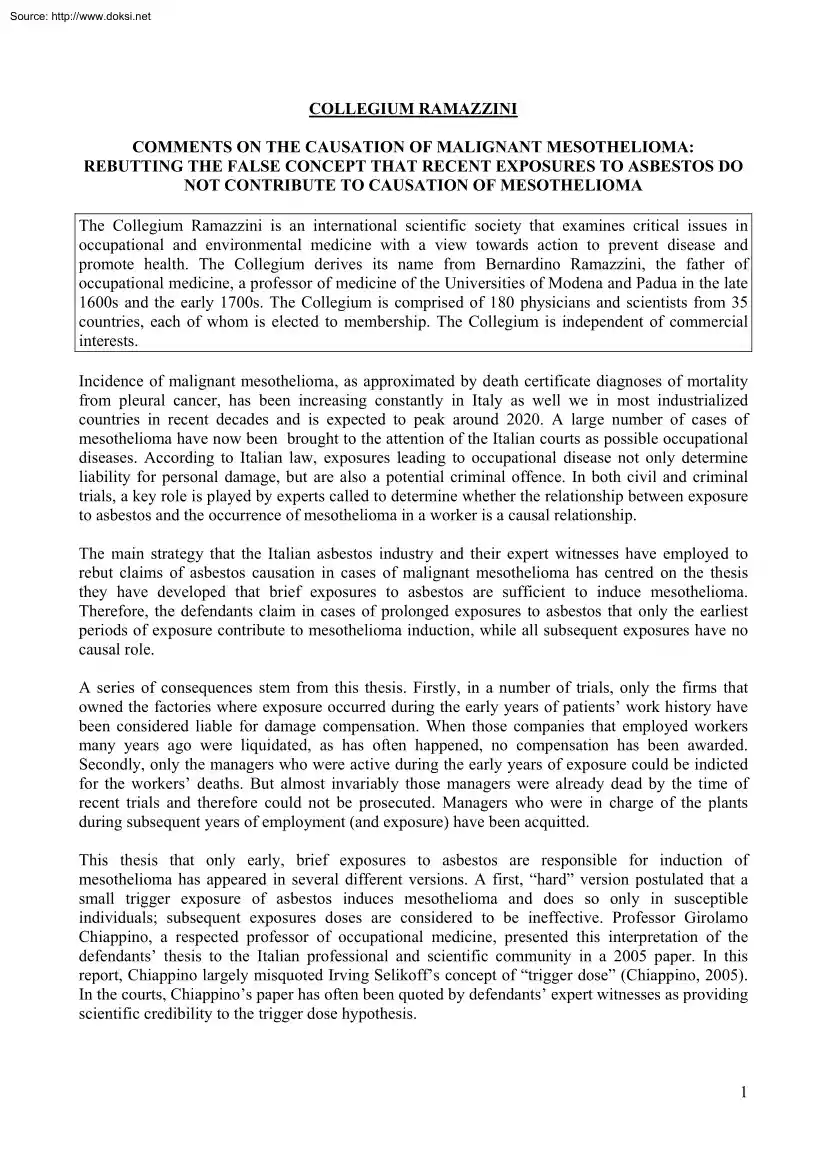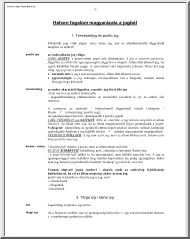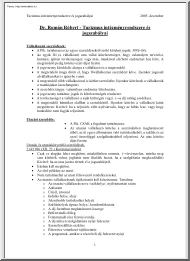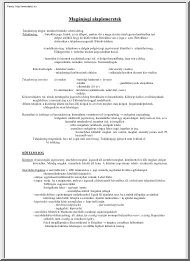Datasheet
Year, pagecount:2015, 3 page(s)
Language:English
Downloads:2
Uploaded:May 13, 2019
Size:540 KB
Institution:
-
Comments:
Attachment:-
Download in PDF:Please log in!
Comments
No comments yet. You can be the first!Most popular documents in this category
Content extract
Source: http://www.doksinet COLLEGIUM RAMAZZINI COMMENTS ON THE CAUSATION OF MALIGNANT MESOTHELIOMA: REBUTTING THE FALSE CONCEPT THAT RECENT EXPOSURES TO ASBESTOS DO NOT CONTRIBUTE TO CAUSATION OF MESOTHELIOMA The Collegium Ramazzini is an international scientific society that examines critical issues in occupational and environmental medicine with a view towards action to prevent disease and promote health. The Collegium derives its name from Bernardino Ramazzini, the father of occupational medicine, a professor of medicine of the Universities of Modena and Padua in the late 1600s and the early 1700s. The Collegium is comprised of 180 physicians and scientists from 35 countries, each of whom is elected to membership. The Collegium is independent of commercial interests. Incidence of malignant mesothelioma, as approximated by death certificate diagnoses of mortality from pleural cancer, has been increasing constantly in Italy as well we in most industrialized countries in recent
decades and is expected to peak around 2020. A large number of cases of mesothelioma have now been brought to the attention of the Italian courts as possible occupational diseases. According to Italian law, exposures leading to occupational disease not only determine liability for personal damage, but are also a potential criminal offence. In both civil and criminal trials, a key role is played by experts called to determine whether the relationship between exposure to asbestos and the occurrence of mesothelioma in a worker is a causal relationship. The main strategy that the Italian asbestos industry and their expert witnesses have employed to rebut claims of asbestos causation in cases of malignant mesothelioma has centred on the thesis they have developed that brief exposures to asbestos are sufficient to induce mesothelioma. Therefore, the defendants claim in cases of prolonged exposures to asbestos that only the earliest periods of exposure contribute to mesothelioma induction,
while all subsequent exposures have no causal role. A series of consequences stem from this thesis. Firstly, in a number of trials, only the firms that owned the factories where exposure occurred during the early years of patients’ work history have been considered liable for damage compensation. When those companies that employed workers many years ago were liquidated, as has often happened, no compensation has been awarded. Secondly, only the managers who were active during the early years of exposure could be indicted for the workers’ deaths. But almost invariably those managers were already dead by the time of recent trials and therefore could not be prosecuted. Managers who were in charge of the plants during subsequent years of employment (and exposure) have been acquitted. This thesis that only early, brief exposures to asbestos are responsible for induction of mesothelioma has appeared in several different versions. A first, “hard” version postulated that a small
trigger exposure of asbestos induces mesothelioma and does so only in susceptible individuals; subsequent exposures doses are considered to be ineffective. Professor Girolamo Chiappino, a respected professor of occupational medicine, presented this interpretation of the defendants’ thesis to the Italian professional and scientific community in a 2005 paper. In this report, Chiappino largely misquoted Irving Selikoff’s concept of “trigger dose” (Chiappino, 2005). In the courts, Chiappino’s paper has often been quoted by defendants’ expert witnesses as providing scientific credibility to the trigger dose hypothesis. 1 Source: http://www.doksinet A second, “soft” version of the thesis is now more often used. It is summarized in the following words presented in a review article by La Vecchia and Boffetta: “for workers occupationally exposed in the distant past, the risk of mesothelioma is not appreciably influenced by subsequent exposures” (La Vecchia and Boffetta,
2012). This review was submitted for publication in September 2011 and its content closely matched La Vecchia’s examination as expert witness for the defense in the Montefibre asbestos trial in Verbania, Italy in March 2011. The proofs of this article were produced as defence exhibit in the Montefibre appeal trial in Turin in November 2011. La Vecchia and Boffetta’s paper (and the thesis it promotes) have little scientific merit. It is based on a biased and highly selective review of the published literature (Terracini et al, 2014). In 2011, the Epidemiology and Public Health Working Group of the Second Italian Consensus Conference on Pleural Mesothelioma conducted an independent systematic review of the literature on the dose-response relationship between asbestos and mesothelioma. It concluded that there is convincing evidence that mesothelioma incidence is proportional to cumulative asbestos exposure (Pinto et al, 2013; Magnani et al, 2013). The Working Group states that
“Subsequent” exposures cannot, thus, be considered without influence on mesothelioma risk on the basis of the available evidence, as they necessarily contribute to cumulative dose”. Timing of exposure was recognized by the Italian Working Group to be important. The Working Group noted that the same increase in exposure was more effective when it occurred early during a prolonged exposure. There was, however, no mention in the Working Group’s report of a time limit beyond which further increases in exposure would cause no further increases in risk of mesothelioma, nor was there any statement that such a limit should be set after a few years of exposure. The concept that mesothelioma incidence is proportional to cumulative asbestos exposure was further confirmed in a 2015 review of published epidemiological studies which analyzed separately the role of intensity and duration of asbestos exposure (III Italian Consensus Conference). This analysis found that both variables are
determinant of mesothelioma risk. In summary, the Collegium Ramazzini concludes that risk of malignant mesothelioma is related to cumulative exposure to asbestos in which all exposures – early as well as late – contribute to the totality of risk. The Collegium Ramazzini rejects as false, mendacious, and scientifically unfounded the claim put forth by the Italian asbestos industry and its expert witnesses that in cases of prolonged exposures to asbestos only the earliest periods of exposure contribute to mesothelioma induction, while all subsequent exposures have no causal role. The Collegium Ramazzini is deeply concerned that acceptance of this false claim will contribute to the unjust denial of workers’ compensation and civil damages to affected workers, that it will hinder efforts to diagnose and prevent malignant mesothelioma, and that ultimately it will undermine the health of the public in Italy and in countries around the world. 2 Source: http://www.doksinet References
Chiappino G [Mesothelioma: the aetiological role of ultrathin fibres and repercussions on prevention and medical legal evaluation]. Med Lav 2005;96:3-23 (In Italian) La Vecchia C, Boffetta P. Role of stopping exposure and recent exposure to asbestos in the risk of mesothelioma. Eur J Cancer Prev 2012;21:227-30 Magnani C et al. Pleural mesothelioma: epidemiological and public health issues Report from the Second Italian Consensus Conference on Pleural Mesothelioma. Med Lav 2013;104:191-202 Pinto C et al. Second Italian consensus conference on malignant pleural mesothelioma: state of the art and recommendations. Cancer Treat Rev 2013;39:328-39 Terracini B et al A critique to a review on the relationship between asbestos exposure and the risk of mesothelioma. Eur J Cancer Prev 2014;23:492-4 Third Italian Conference on Malignant Mesothelioma of the Pleura: epidemiology, Public Health and Occupational Medicine related issues, La Medicina del Lavoro in press 3
decades and is expected to peak around 2020. A large number of cases of mesothelioma have now been brought to the attention of the Italian courts as possible occupational diseases. According to Italian law, exposures leading to occupational disease not only determine liability for personal damage, but are also a potential criminal offence. In both civil and criminal trials, a key role is played by experts called to determine whether the relationship between exposure to asbestos and the occurrence of mesothelioma in a worker is a causal relationship. The main strategy that the Italian asbestos industry and their expert witnesses have employed to rebut claims of asbestos causation in cases of malignant mesothelioma has centred on the thesis they have developed that brief exposures to asbestos are sufficient to induce mesothelioma. Therefore, the defendants claim in cases of prolonged exposures to asbestos that only the earliest periods of exposure contribute to mesothelioma induction,
while all subsequent exposures have no causal role. A series of consequences stem from this thesis. Firstly, in a number of trials, only the firms that owned the factories where exposure occurred during the early years of patients’ work history have been considered liable for damage compensation. When those companies that employed workers many years ago were liquidated, as has often happened, no compensation has been awarded. Secondly, only the managers who were active during the early years of exposure could be indicted for the workers’ deaths. But almost invariably those managers were already dead by the time of recent trials and therefore could not be prosecuted. Managers who were in charge of the plants during subsequent years of employment (and exposure) have been acquitted. This thesis that only early, brief exposures to asbestos are responsible for induction of mesothelioma has appeared in several different versions. A first, “hard” version postulated that a small
trigger exposure of asbestos induces mesothelioma and does so only in susceptible individuals; subsequent exposures doses are considered to be ineffective. Professor Girolamo Chiappino, a respected professor of occupational medicine, presented this interpretation of the defendants’ thesis to the Italian professional and scientific community in a 2005 paper. In this report, Chiappino largely misquoted Irving Selikoff’s concept of “trigger dose” (Chiappino, 2005). In the courts, Chiappino’s paper has often been quoted by defendants’ expert witnesses as providing scientific credibility to the trigger dose hypothesis. 1 Source: http://www.doksinet A second, “soft” version of the thesis is now more often used. It is summarized in the following words presented in a review article by La Vecchia and Boffetta: “for workers occupationally exposed in the distant past, the risk of mesothelioma is not appreciably influenced by subsequent exposures” (La Vecchia and Boffetta,
2012). This review was submitted for publication in September 2011 and its content closely matched La Vecchia’s examination as expert witness for the defense in the Montefibre asbestos trial in Verbania, Italy in March 2011. The proofs of this article were produced as defence exhibit in the Montefibre appeal trial in Turin in November 2011. La Vecchia and Boffetta’s paper (and the thesis it promotes) have little scientific merit. It is based on a biased and highly selective review of the published literature (Terracini et al, 2014). In 2011, the Epidemiology and Public Health Working Group of the Second Italian Consensus Conference on Pleural Mesothelioma conducted an independent systematic review of the literature on the dose-response relationship between asbestos and mesothelioma. It concluded that there is convincing evidence that mesothelioma incidence is proportional to cumulative asbestos exposure (Pinto et al, 2013; Magnani et al, 2013). The Working Group states that
“Subsequent” exposures cannot, thus, be considered without influence on mesothelioma risk on the basis of the available evidence, as they necessarily contribute to cumulative dose”. Timing of exposure was recognized by the Italian Working Group to be important. The Working Group noted that the same increase in exposure was more effective when it occurred early during a prolonged exposure. There was, however, no mention in the Working Group’s report of a time limit beyond which further increases in exposure would cause no further increases in risk of mesothelioma, nor was there any statement that such a limit should be set after a few years of exposure. The concept that mesothelioma incidence is proportional to cumulative asbestos exposure was further confirmed in a 2015 review of published epidemiological studies which analyzed separately the role of intensity and duration of asbestos exposure (III Italian Consensus Conference). This analysis found that both variables are
determinant of mesothelioma risk. In summary, the Collegium Ramazzini concludes that risk of malignant mesothelioma is related to cumulative exposure to asbestos in which all exposures – early as well as late – contribute to the totality of risk. The Collegium Ramazzini rejects as false, mendacious, and scientifically unfounded the claim put forth by the Italian asbestos industry and its expert witnesses that in cases of prolonged exposures to asbestos only the earliest periods of exposure contribute to mesothelioma induction, while all subsequent exposures have no causal role. The Collegium Ramazzini is deeply concerned that acceptance of this false claim will contribute to the unjust denial of workers’ compensation and civil damages to affected workers, that it will hinder efforts to diagnose and prevent malignant mesothelioma, and that ultimately it will undermine the health of the public in Italy and in countries around the world. 2 Source: http://www.doksinet References
Chiappino G [Mesothelioma: the aetiological role of ultrathin fibres and repercussions on prevention and medical legal evaluation]. Med Lav 2005;96:3-23 (In Italian) La Vecchia C, Boffetta P. Role of stopping exposure and recent exposure to asbestos in the risk of mesothelioma. Eur J Cancer Prev 2012;21:227-30 Magnani C et al. Pleural mesothelioma: epidemiological and public health issues Report from the Second Italian Consensus Conference on Pleural Mesothelioma. Med Lav 2013;104:191-202 Pinto C et al. Second Italian consensus conference on malignant pleural mesothelioma: state of the art and recommendations. Cancer Treat Rev 2013;39:328-39 Terracini B et al A critique to a review on the relationship between asbestos exposure and the risk of mesothelioma. Eur J Cancer Prev 2014;23:492-4 Third Italian Conference on Malignant Mesothelioma of the Pleura: epidemiology, Public Health and Occupational Medicine related issues, La Medicina del Lavoro in press 3





 When reading, most of us just let a story wash over us, getting lost in the world of the book rather than paying attention to the individual elements of the plot or writing. However, in English class, our teachers ask us to look at the mechanics of the writing.
When reading, most of us just let a story wash over us, getting lost in the world of the book rather than paying attention to the individual elements of the plot or writing. However, in English class, our teachers ask us to look at the mechanics of the writing.